Alan M. Siegel's Blog, page 11
October 4, 2023
Harnessing the power of brand to navigate uncertainty in the pharmaceuticals industry
This article originally appeared in PharmaTimes.
The pharmaceutical industry has undergone a seismic shift over the past few years. Boardrooms are simultaneously grappling with new regulatory landscapes, maintaining brand equity in fractured markets, expanding into unfamiliar territories, and stabilizing supply chains still impacted by the pandemic. Unsurprisingly, management teams may find themselves in a state of flux.
On top of that, interest rates at a decade-high and geopolitical volatility have had a dampening effect in a sector where mergers and acquisitions (M&A) have traditionally been seen as a key strategic lever for growth.
That said, green shoots are appearing.
The market is warming up again, presenting a renewed window of opportunity for brand growth. Within this landscape, a new class of Chief Marketing Officer (CMO) has emerged. These leaders are looking to embrace the defining challenges of the modern pharma sector by leading opportunities for M&A, rediscovering purpose, attracting next-generation talent, and differentiating their brands in a crowded marketplace.
The convergence of these challenges and opportunities carries profound implications for the brands involved. In this symbiotic dance of adaptation and innovation, marketing leaders are seen as navigators, steering their organizations to help reshape their business and propel their brands toward long-term success.
Indeed, in 2019, shortly after the acquisition of Celgene (a leading biotech company), Biopharma company Bristol-Myers Squibb (BMS) saw an urgent need to update its brand with a new strategic direction in light of this development. The new brand had to be fresh and more representative of who they are and who they will be in the future, and establish BMS as a diversified specialty biopharma leader with a refocused story that places the patient at the heart.
In large-scale transactions of this kind, essential brand considerations are at play to ensure longevity. Below are the four key considerations for pharma CMOs looking to propel their brand forward successfully.
Shifting brand paradigmsThe uptick in M&A activity within the pharmaceutical industry means marketing leaders have to act sooner rather than later. M&As often necessitate a shift in a company’s identity, demanding swift adaptation to the new reality. If executed well, the rewards are plain to see: new market penetration, increased share price, and improved operating efficiencies. The true brand challenge, however, lies in integrating all the moving pieces. As pharma giants expand their portfolios, marketing leaders find themselves at a crossroads with a clear need to align the conglomerate’s strengths while leveraging, and not losing, the equities of the legacy brands.
Personalized pharma marketingAbsorbing the right innovation and emerging technology through M&A is a sure way to boost internal capabilities and expedite pipeline timelines, ultimately ensuring more efficiency and a faster path to growth.
BMS explains: “With reimbursement systems in Europe, you now see the patient voice at the table. We work to understand their needs, we call it ‘going beyond the pill.’ It’s a hugely exciting area in personalized medicine because the future of R&D is centered around designing medication for your DNA.”
With the patient at the heart of R&D efforts more than ever, brand leaders must ask themselves how to reach all consumers through one brand when every patient is treated as an individual. This gives rise to important considerations around data acquisition and tailored communication channels to reach people at an increasingly personal level.
Purpose-driven relevanceIn the crowded pharma landscape, relevance hinges on articulating a clear and compelling purpose. Pharma brands must amplify their reason for being in a way that aligns with their core strategic objectives and galvanizes the discerning talent audience they seek to attract. As BMS pointed out: “Purpose is critical to attract talent, and it needs to be authentically communicated within the organization.” A company’s purpose needs to be evident in its actions and not just its words because tomorrow’s talent can sniff out the slightest note of insincerity.
Novartis was able to embrace this successfully. After consolidation efforts, the company recognized its transformative power and embraced simple positioning as an R&D-led Life Sciences company. This evolution became deeply ingrained in Novartis’ organizational culture, propelling the company into a new era of purpose-driven innovation. This helped to attract and retain a new pool of talent looking to work for a business where they could play a key role in reshaping the industry for the better.
Medtronic, too, showcases this strategic thinking: a clear position centered on technology’s profound impact on healthcare allows the company to attract a younger, tech-savvy talent pool that resonates with its brand orientation and helps move the organization into a new era. Medtronic’s purpose even expands from healthcare into planetary welfare, extending their brand messaging on “healthy lives” to a “healthy planet,” with regular ESG reporting that demonstrates the authenticity of their purpose.
When science meets art: differentiation + positioningAmid the increasing threat from unbranded and generic rivals, pharma brands must carve out their own space to gain an advantage over competitors. Abbott’s positioning, for example, combines heritage, adaptability, and innovation. By aligning its R&D efforts with unleashing human potential, the company created a unique identity and charted a course where legacy blends seamlessly with future potential.
CMOs must also ask themselves how their organizations will continue to deliver differently and stay front of mind for the scientific community in these choppy waters.
BMS, Novartis, Abbott, and Medtronic illuminate the strategic pathways CMOs can take, elevating brands beyond their services. As M&A activity begins to shape the industry again, these tools transform into not just survival instruments but transformation catalysts, enabling pharma brands to thrive amidst uncertainty, navigate complexity, and emerge as innovation beacons in an unpredictable landscape.
What do they all have in common?Ultimately, simplicity emerges as a guiding principle underlying these brand strategies. In a complex landscape, distilling who you are and what you’re about to its purest form is the key to guiding brands during their transformation phase. Much is at stake when companies merge or are acquired – for the companies, employees, and shareholders. Companies can only move forward easily by knowing where they are going; brands that incorporate simplicity into their DNA get there with focus, standing out from the crowd and propelling them towards enduring success.
Emma Lewis is a Senior Strategist
The post Harnessing the power of brand to navigate uncertainty in the pharmaceuticals industry appeared first on Siegel+Gale.
October 2, 2023
The role of brand in M&A: Financial Services
The post The role of brand in M&A: Financial Services appeared first on Siegel+Gale.
Is AI good news or bad news for branding? 3 smart uses for brand builders
This article originally appeared in The Drum
The advent of generative artificial intelligence (AI) like ChatGPT has forced creatives of all disciplines, including those working in brand building, into the uncomfortable position of wondering whether they’ve just been replaced; rendered obsolete.
But (and setting aside for a moment the well-known ethical and legal landmines) could AI actually generate best-in-class creative? Could it hear a client say one word in a meeting and then create an inspired, caffeine-rich manifesto out of it? Could it come up with iconic lines like “Snap, Crackle, and Pop” or “I’m Lovin’ It”? Could it be a tool for creatives to celebrate rather than fear? Here are three ways creatives of all stripes, including those in branding, can think about AI as a tool to simplify and magnify how they work (and not fear being replaced).
1. AI is a grocery store, not a Michelin star dinnerGenerative AI can spit out a huge volume of words, phrases and ideas in seconds, but that does not mean those outputs represent best-in-class work or are even ready to consume. What you get are ingredients, not insights or instincts. While AI is a powerful brainstorming partner, like a supercharged thesaurus-meets-search engine, AI doesn’t know a brand’s audiences, competition and culture, or how to collaborate with and manage the expectations of stakeholders.
This lack of human inventiveness, self-analysis and interpersonal soft skills means that AI produces results that are limited to grab-and-go quality, like a supermarket spinach wrap. Think of AI-generated output as a jumping-off point for ideas that will still require a unique human perspective. This is especially true in the world of branding; since brand is what people feel about you, the most powerful implementation of technology is the one guided by a human touch.
2. AI content is a ‘sea of sameness’ – unless you know how to find treasureThe large language models that power generative AI are always going to produce the most generic output – unless you know how to dive below the surface for unique or unexpected insights. For example, if you give AI the prompt, ‘Give me 10 unique ideas for an energy trade show’, you’ll get the same ‘unique’ ideas most have already tried. But if you use the prompt, ‘Give me 10 unexpected ideas for an energy trade show using the cosmos as inspiration. Do not provide ideas on product innovation. Provide ideas on getting attention at the trade show with signage, collateral, and interactive events,’ then you might be getting somewhere.
For best-in-class work, AI results that are worth surfacing will require humans with finely tuned creative instincts.
3. AI boosts human creativityAI helps creatives brainstorm faster, like having an extra set of hands or an Iron Man suit. But it can’t replace human creativity. AI is a predictor, not a connector; it generates words and images by probability without analysis or cross-referencing. Furthermore, AI is a rule-follower, not an inventor; it replicates writing essentials and techniques, but it’s unfamiliar with the latest ideas or how to create new ones.
The rising prominence of prompt engineers suggests the discovery of a new pathway for creativity and discovery, one that recognizes that by giving us new tools, AI broadens the scale of what we can imagine. And the efficiencies it enables can be invested by smart branding firms into allocating more uninterrupted creative thinking time, empowering creatives to ask increasingly rigorous and imaginative questions, which leads to greater innovation.
Is AI good news or bad news for brand? It would obviously be bad news if we were to step on any of the legal, ethical or existential landmines. But if it can be properly developed, implemented, and regulated by humans, AI is very good news for brand, and the creative thinkers behind it. AI doesn’t replace human creatives; it equips them for an intrinsically human effort: finding joy in the struggle for just the right way to express just the right concept in a completely unexpected way. It’s that process of discovery that defines the art of human connection and persuasion, and informs the work of crafting best-in-class brands.
Analicia Sotelo is Associate Director, Brand Communication and Scott Wolman is Associate Director, Naming.
The post Is AI good news or bad news for branding? 3 smart uses for brand builders appeared first on Siegel+Gale.
September 25, 2023
Drag up your brand
This article originally appeared in Campaign US.
When RuPaul’s Drag Race (RPDR) first aired in 2009, it was a quirky little show with a terrible filter and a small fanbase.
Cut to today, it’s grown from a guilty pleasure among the few and the fierce, to a commercial success and a defining part of the zeitgeist.
But what transformed the humble show into a cultural juggernaut?
Four words: Charisma, Uniqueness, Nerve and Talent.
If you’ve ever seen RPDR, you’ve heard them. They’re the judging criteria, an iconic catchphrase and a wink-nudge joke. They also encapsulate pivotal principles in brand-building – which have been core to the show’s enduring success.
Let’s take Charisma.The magnetic je ne sais quoi that makes someone captivating. It’s what RuPaul has identified as “star quality” in performers like Luxx Noir London. It is also that iconic essence of the show that keeps audiences hooked, quoting soundbites and creating lore.
It’s similar to the “It” factor that brands like Apple possess. It’s why there are millions of devoted Apple fans (myself included) who can’t fully articulate why they are so bought in. Yes, Apple makes gorgeous, quality products, but so does the competition; which points to a critical piece of the equation: Charisma.
Or, in brandspeak, “brand essence” – what Ipsos calls “the soul of the brand; the brand’s fundamental nature or quality.” Apple has long been clear about defining and delivering on this — so clear that it inspires loyalty globally, from Silicon Valley to Saltpond.
Which brings us to Uniqueness.Let’s think of uniqueness as the anchor that grounds charisma. If charisma is the je ne sais quoi, uniqueness is the quoi – is the thing you can put your finger on.
An RPDR contestant’s uniqueness is measured by the originality of their drag — including their personal style, creative perspective and ability to bring something fresh to the stage. The show itself reflects this uniqueness. When it premiered, it was arguably its own category of TV: an amalgamation of familiar genres but wholly distinct, setting the stage for success.
One thing that distinguishes a great brand is a wholly ownable identity. Like people, brands flourish when they own what makes them special. That’s what Airbnb, Netflix and Dollar Shave Club did. As game-changing brands that disrupted the market, they dared to differ – and it paid big. It’s about getting clear and specific on what is unique about your brand’s purpose, promise, personality and offerings — and translating that across every aspect of the experience.
But it takes Nerve.On RPDR, this could mean a performer ripping off a wig to reveal another (or two), or flinging herself into a mid-air pirouette and then plummeting into a split – and trusting she will land as planned. It is courage. Boldness. Sheer fearlessness. It’s the audacity to swing big.
At a time when drag was primarily enjoyed by an LGBTQ+ audience, celebrating and elevating drag as an art form was ballsy. It took nerve to air the show.
This mirrors moves by some iconic brands. For instance, when Nike supported Colin Kaepernick’s social justice stance, it was risky business. A prominent and well-loved brand, Nike stood to alienate a huge segment of its consumers – but it took the risk anyway. Yes, in the immediate aftermath of the Dream Crazy campaign, Nike took a hit. There were calls for boycotts and its stock price dipped. However, in the long run, this nervy move ramped up its revenue. Plus, the stock rebounded, with Nike’s market value soaring to an all-time high in 2019.
So, what is the role of talent?Without talent, one could argue none of the above matters. On RPDR, talent is a mastery of dance, theater, sewing, applying opera-grade makeup, lip-syncing for your life and always having a fresh bag of tricks to delight fans. In practical terms, we could define talent as doing one’s job inimitably well.
This is another reason RPDR blossomed into a cultural mainstay: It absolutely excelled at its job of entertaining (and continues to). Combining reality TV, competition and drag culture, held together with humor and heart, it promised something both familiar and fresh. And it delivered.
This is also what brands like Google exhibit: big promise, big delivery. It’s no surprise that Google often tops out so many brand surveys. It consistently delivers on its promise to “organize the world’s information and make it universally accessible and useful.” Google does its job, and does it with a clarity and spark that exceeds expectations.
Brand-building goes beyond these four principles alone. But RPDR’s use of Charisma, Uniqueness, Nerve, and Talent is masterful and insightful, and it works (and werks) — and hopefully, it will work for your brand, too.
Condragulations, in advance!
Nana T. Baffour-Awuah is Associate Director, Brand Communication
The post Drag up your brand appeared first on Siegel+Gale.
September 4, 2023
Omnicom Health Group: changing lives for good
In SMPL Q+A, we interview our practitioners on all things relevant to branding, design and simplicity. Here, we speak with our experts about our work with Omnicom Health Group (OHG) . OHG is a global collective of diverse healthcare marketing and communications companies. In July 2023, OHG unveiled its rebranding efforts, debuting a new logo and design elements as well as prioritizing a brand narrative that clarifies the complexity of the network’s portfolio for clients and employees alike.

Why did Omnicom Health Group (OHG) engage Siegel+Gale?
Katie Conway, General Manager, West Coast: In the past, OHG operated as a traditional holding company and hadn’t invested in defining and communicating its brand. But when Matt McNally joined as CEO twelve months ago, he brought a bold ambition to be the most networked global health network. To achieve that vision, they needed a brand that would clearly articulate what OHG does and the unique value it provides.
How does the new brand narrative elevate the positioning of OHG?
Katie Conway, General Manager, West Coast: To inform the narrative development, we did listening sessions with employees from across the 30,000+ person network. In those conversations, we heard some concern that OHG, as the holding company, was coming in to take over. But that wasn’t the case at all. In fact, Matt and the leadership team believed it was the differences within OHG that drove its impact—and this is what the narrative captures. It celebrates the unique agencies and individuals within the network, positioning OHG not as the center and administrator but as the foundation and connector that creates unexpected connections across agencies, individuals and clients to create innovative and impactful solutions.
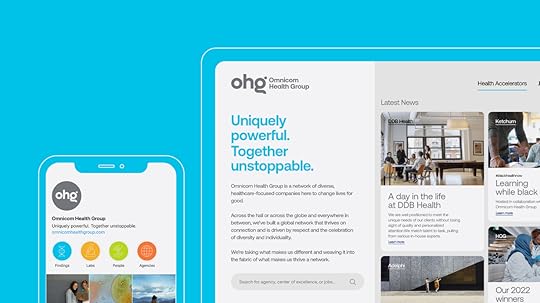
What was the concept behind the logo & visual identity? Any inspiration you would like to call out?
Simrit Brar, Creative Director: We were very inspired by the positioning: ‘Uniquely powerful. Together unstoppable’. It captures that each agency and individual at OHG brings their best self and uniqueness, but together, they think bigger and create something exceptional.
This, when translated to the design approach, led to ‘connected rhythms’: By bouncing ideas off one another, we progress further and grow faster. Each of our rhythms has its own beat, but together, they connect and iterate to form new, more innovative patterns and tempos. These rhythms start with each of us and move outwards to combine and create new beats every day and everywhere.
We wanted the visual system to balance humanity with science in a way that felt like it had moments of boldness and the right amount of restraint since it had to flex well for audiences that were both employees at various agencies but also a range of health clients. This was important as OHG is a network with many agencies with unique identities. It was important that OHG not compete with them.

How does the new brand identity reflect OHG’s commitment to being the best healthcare agency network in the world?
Simrit Brar: OHG’s new brand identity reflects its ambition and commitment to its integrated, diverse teams and new partnerships. From the repetitive circular element in the logo to the bold, rhythmic visual system, the design language for OHG became approachable and energetic, capturing both humanity and the power of the collective.
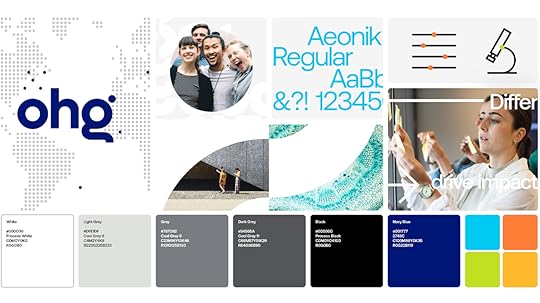
To learn more about our partnership with OHG, tune into our Siegel+Gale Says podcast for a conversation that explores how to utilize brand to implement a CEO’s new ambition.
The post Omnicom Health Group: changing lives for good appeared first on Siegel+Gale.
Omnicom Heath Group: changing lives for good
In SMPL Q+A, we interview our practitioners on all things relevant to branding, design and simplicity. Here, we speak with our experts about our work with Omnicom Heath Group (OHG) . OHG is a global collective of diverse healthcare marketing and communications companies. In July 2023, OHG unveiled its rebranding efforts, debuting a new logo and design elements as well as prioritizing a brand narrative that clarifies the complexity of the network’s portfolio for clients and employees alike.

Why did Omnicom Health Group (OHG) engage Siegel+Gale?
Katie Conway, General Manager, West Coast: In the past, OHG operated as a traditional holding company and hadn’t invested in defining and communicating its brand. But when Matt McNally joined as CEO twelve months ago, he brought a bold ambition to be the most networked global health network. To achieve that vision, they needed a brand that would clearly articulate what OHG does and the unique value it provides.
How does the new brand narrative elevate the positioning of OHG?
Katie Conway, General Manager, West Coast: To inform the narrative development, we did listening sessions with employees from across the 30,000+ person network. In those conversations, we heard some concern that OHG, as the holding company, was coming in to take over. But that wasn’t the case at all. In fact, Matt and the leadership team believed it was the differences within OHG that drove its impact—and this is what the narrative captures.
It celebrates the unique agencies and individuals within the network, positioning OHG not as the center and administrator but as the foundation and connector that creates unexpected connections across agencies, individuals and clients to create innovative and impactful solutions.
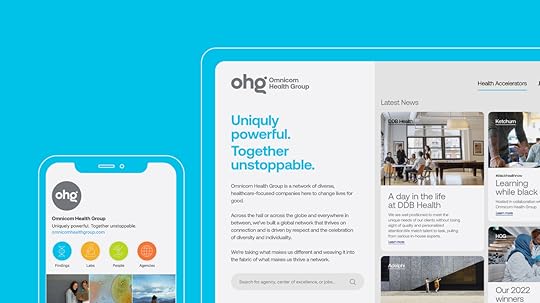
What was the concept behind the logo & visual identity? Any inspiration you would like to call out?
Simrit Brar, Creative Director: We were very inspired by the positioning: ‘Uniquely powerful. Together unstoppable’. It captures that each agency and individual at OHG brings their best self and uniqueness, but together, they think bigger and create something exceptional.
This, when translated to the design approach, led to ‘connected rhythms’: By bouncing ideas off one another, we progress further and grow faster. Each of our rhythms has its own beat, but together, they connect and iterate to form new, more innovative patterns and tempos. These rhythms start with each of us and move outwards to combine and create new beats every day and everywhere.
We wanted the visual system to balance humanity with science in a way that felt like it had moments of boldness and the right amount of restraint since it had to flex well for audiences that were both employees at various agencies but also a range of health clients. This was important as OHG is a network with many agencies with unique identities. It was important that OHG not compete with them.

How does the new brand identity reflect OHG’s commitment to being the best healthcare agency network in the world?
Simrit Brar: OHG’s new brand identity reflects its ambition and commitment to its integrated, diverse teams and new partnerships. From the repetitive circular element in the logo to the bold, rhythmic visual system, the design language for OHG became approachable and energetic, capturing both humanity and the power of the collective.

To learn more about our partnership with OHG, tune into our Siegel+Gale Says podcast for a conversation that explores how to utilize brand to implement a CEO’s new ambition.
The post Omnicom Heath Group: changing lives for good appeared first on Siegel+Gale.
August 28, 2023
Under the sea: unlocking new creative horizons with AI
In partnership with Microsoft, our global creative team harnessed the AI power of Bing Image Creator to imagine a series of fantastical sea creatures. Featured in the Microsoft Beach House at Cannes Lions 70, our designers’ 18 submissions immersed audiences in a vibrant, underwater world—and underscored AI’s ability to amplify our creativity and human ingenuity.
https://www.siegelgale.com/app/uploads/2023/08/AI_Creatures_02.mp4What did our global design team learn through the AI-powered process? Here are key takeaways for creators experimenting with generative AI tools:
 Articulate a clear vision by giving AI platforms enough direction as you iterate toward a desired result.
Articulate a clear vision by giving AI platforms enough direction as you iterate toward a desired result. Using generative AI in collaboration with others is an amazing way to boost innovation.
Using generative AI in collaboration with others is an amazing way to boost innovation. Prioritize making a human connection from the beginning as the best outputs elicit an emotional response.
Prioritize making a human connection from the beginning as the best outputs elicit an emotional response.
Thank you to Microsoft for inviting us to take part, and congratulations to our designers—Alec Klein, Sandra Ferreira Reynolds, Clinton Clarke, Holly Parkin, Fernanda Canellas, Elizabeth Motolese, Nijel Taylor and Bableen Chopra—on these unforgettable works of art.
The post Under the sea: unlocking new creative horizons with AI appeared first on Siegel+Gale.
August 24, 2023
Simply Smarter: A newsletter on brand experience (July 2023)
In this month’s newsletter, you’re invited to our next Unlocking Brand webinar with global B2B product leader BorgWarner. Our Co-CEO + Chief Strategy Officer, David Srere, delves into our “simplicity” philosophy on the latest episode of Brand Master Podcast, discussing how best to embrace simplicity in a competitive market. Matt Egan, Managing Director, Strategy, explores brand building and brand strategy in an M&A context. And, catch up on our recent media features: like a new op-ed on AI uses for brand builders—penned by our Associate Director of Brand Communication, Analicia Sotelo, and Associate Director of Naming, Scott Wolman—and Adweek’s Tools of the Trade series, where our Design Director, Fernanda Canellas, is featured.
 You’re invited: How do you leverage brand for a B2B business transformation?
You’re invited: How do you leverage brand for a B2B business transformation?Join us on July 18th for our next virtual Unlocking Brand event featuring a conversation on how to leverage brand for transformation in a B2B enterprise. Global CMO Margaret Molloy will host Michelle Collins, Global Director, Marketing and Public Relations, BorgWarner, a global product leader in innovative and sustainable mobility solutions for the vehicle market. Along with Siegel+Gale’s Matt Egan and Jason Miller, they will explore how to link business transformation with brand strategy, develop a dynamic logo and future-proof it and activate a new brand that supports all stakeholders.
 Can AI be a valuable tool for brand builders?
Can AI be a valuable tool for brand builders?Associate Director, Brand Communication, Analicia Sotelo, and Associate Director, Naming, Scott Wolman share three ways creatives of all stripes can think about AI as a tool to simplify and magnify how they work.
 The simplification strategy
The simplification strategyWant to unlock the power of simplicity to achieve branding success? On the latest episode of Brand Master Podcast, Co-CEO + Chief Strategy Officer, David Srere, explores our “simplicity” philosophy, the common mistakes to avoid in simplification and how to move from the “what” to the “so what.”
 Brand strategy and M&A
Brand strategy and M&A“Corporate transactions create unique opportunities to create lasting brand value. True leaders take advantage of these opportunities to define a new future for themselves and their teams, and to build new brand experiences that motivate customers and mobilize talent.”
Our Managing Director, Strategy, Matt Egan, talks about how brands are built and shares tips for thinking about brand strategy in the context of mergers and acquisitions.
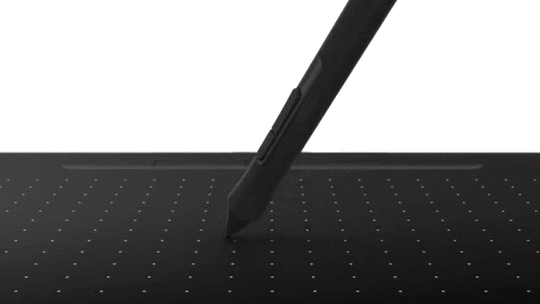 Tools of the trade
Tools of the tradeAdweek’s Tools of the Trade series highlights the many tools that help make creatives successful—from a favorite drafting table to the best software program or a pair of headphones. Our Design Director, Fernanda Canellas, shares the one tool she uses that keeps her performing at top form.
The post Simply Smarter: A newsletter on brand experience (July 2023) appeared first on Siegel+Gale.
August 15, 2023
5 ways to simplify your employee experience
This article originally appeared in Little Black Book.
You arrive at work with the best of intentions, ready to have a productive, fulfilling day. You sit down at your computer and can’t find a file your leader suggested you fold into in a report due that day. After spending 10 minutes asking colleagues and searching through various drives, you locate the file, only to later receive vague feedback on your report that doesn’t align with the strategic direction of your company. By the time the day is over, you’re fatigued, frustrated, and ready for a glass of wine.
Feel familiar?
For most of us, the workday is filled with frictions that get in the way of productivity, our well-being, and ultimately better business results.
But it doesn’t have to be this way.
As companies grow, expand into new industries, acquire businesses, and layer in new tools, the complexity increases, adding more friction into the day-to-day for most employees. This complexity is felt by three out of four employees worldwide.
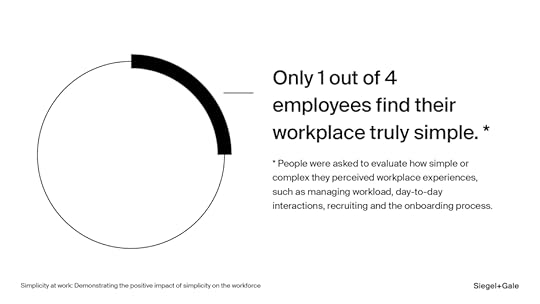
The 25% of employees working in simple workplaces – those where people easily get their work done and feel productive doing so – behave in a unique way. Employees working in this environment go the extra mile. They advocate on behalf of their company, innovate more, and have higher retention rates.
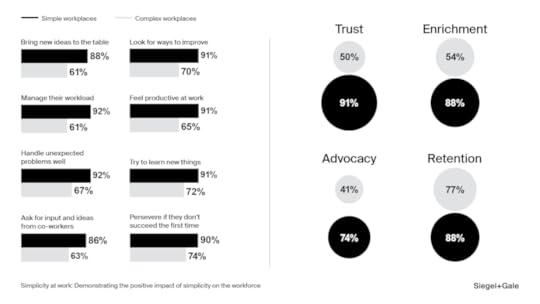
Creating a simple employee experience takes time, intention, and focused effort. Several foundational actions can set the stage for removing complexity, aligning your workforce, and making work easier to do long term. Here are five ways to get started.
#1: Get clear on your brand purpose and values
Employees want to work for a company with a clear purpose beyond financial success. In fact, nine out of 10 employees are willing to earn less money to do more meaningful work . Beyond increasing employee satisfaction, ensuring your company’s brand is guided by an emotionally relevant brand purpose can have big benefits for your bottom line. Companies that are guided by their purpose have 4x revenue growth, 7x job creation, and 12x faster stock price growth. One great example of the impact purpose has is Patagonia, a company that has seen continuous growth over several decades while always putting the planet at the heart of everything it does.
Employees also look for simplicity in terms of how their work is done. For example, decision-making is one of the largest pain points contributing to a complex workplace and employee experience. A strong brand promise paired with clear organizational values can provide a simple filter for decision making, providing clear expectations, helping to align words and actions, and ultimately creating a simpler experience. A good example of this is Netflix’s Culture page, which spells out what the company stands for and clearly defines their values and desired behaviors to set employee expectations well before they even apply for a role.
#2: Find and listen to your brand champions
Brand champions are engaged employees who understand what you stand for and are committed to bringing it to life. According to our research and observations, this group is more likely to look for ways to improve your organization compared to disengaged employees. These employees want their work to matter and contribute to the greater good. If you haven’t already, identify and rally your brand champions and use their input to supplement existing data about your employee experience, such as insights from employee surveys, process improvement initiatives, or external sources like Glassdoor. Your champions will help focus simplicity efforts by identifying quick wins and longer-term initiatives – and possibly help implement them. For example, at Siegel+Gale, some of our brand champions have taken the initiative to re-organize our file structure and naming process, ultimately leading to a simpler work experience.
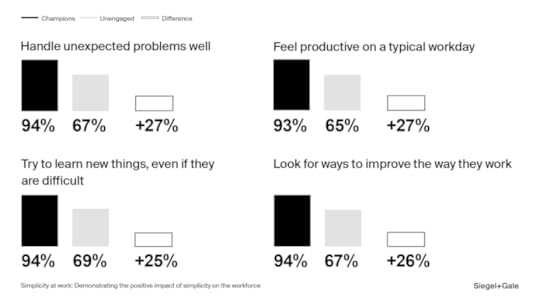
#3: Focus on moments that matter
After uncovering the current state of your employee experience, select several employee touchpoints to simplify – ideally with input from your brand champions. These touchpoints should be 1) important and emotionally relevant moments, 2) tied to your organization’s brand purpose, and 3) focused on experiences in need of simplification. For example, moments like recruiting, onboarding and promotions are high stakes, and often ridden with complexity in most organizations. Simplifying and amplifying these experiences will result in better employee engagement because they leave a lasting impression and are emotionally sticky.
#4: Get clear on your differentiators and follow through on them
Many companies try to be all things to all people, but that’s simply not possible. You must identify differentiators – elements of your employee experience that set your company apart from competitors. Differentiators can be anything from a professional development opportunity that allows talent to move around the world to encouraging risk taking by celebrating organizational failures. Becoming clear on your differentiators helps create a more cohesive and consistent message to both current and prospective talent. Many companies invest in developing an EVP, or Employee Value Proposition, to help define those differentiators and serve as a critical component of the organization’s talent attraction and retention strategy. The EVP articulates what unique things employees should expect from their employer in exchange for their time and talent.
#5: Close the say-do gap
It’s not enough to identify your differentiators or develop an EVP. While focusing on the words is important to setting expectations, follow-through is even more critical. A seamless work experience requires you to not only make a promise to your employees, but ensure that promise is kept.
Simple, clear, communications not only increase employee engagement, but when they’re strategically connected to your brand purpose and values, employees are more likely to have a seamless experience at work. The gap between what your company says and does is smaller, resulting in less friction and frustration among employees.
Train people managers to connect your brand purpose and values to employees’ daily work. When employees can easily connect the dots between their day-to-day and the bigger picture, they’re more likely to be engaged and understand their role in your workplace.
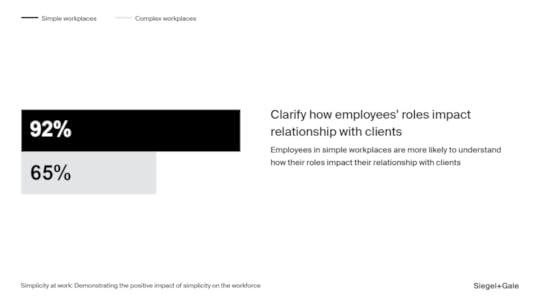
One example of a company with clear internal expression of their purpose is Google. They have a strong culture of transparency and regularly communicate updates and changes to their employees through company-wide meetings and channels, enabling employees to connect and collaborate across teams and departments. This helps to create a sense of community and shared purpose among employees, which can lead to increased engagement and a better employee experience.
Ultimately, the key to a simple, more fulfilling workplace is to make your employees’ experience a priority and to ensure that what you say and do is aligned with the company’s brand purpose and values. By doing so, companies can keep those frustrating workday frictions to a minimal and help ensure employees feel happy and engaged.
Jared Taylor is Associate Director of Brand-led Change. Learn more about the positive effects of simplicity on the workforce through our latest report, Simplicity at work.
The post 5 ways to simplify your employee experience appeared first on Siegel+Gale.
July 27, 2023
How CMOs can simplify their brand’s experience
In today’s rapidly evolving market—a world riddled with complexity—simplicity has emerged as a driving force behind successful brand experiences. Head of Strategy, EMEA, Rishi Dhir, delves into the concept of brand experience and unveils why the best brand experiences have simplicity at their core. Below he provides practical guidance for Chief Marketing Officers (CMOs) seeking to harness the potential of brand experience, shedding light on its transformative power and offering insights into successful brands that have embraced simplicity.
Simplicity matters.
As the world spins ever-faster on its axis of complexity and our lives become increasingly saturated with choice, noise and data, a single truth stands clear: simplicity isn’t just an idea—it’s a strategic imperative.
Brands that simplify our day-to-day by focusing on the core of their offering, stripping away extraneous detail and executing elegantly with a ‘customer-first’ mindset; are those that find success. This intentional effort to simplify results in easy-to-grasp solutions, straightforward interactions and clear communication, elements that not only drive brand salience but also create brand value.
Indeed, our World’s Simplest Brands report reveals that 57% of consumers are willing to pay more for simpler experiences and 76% are more likely to recommend brands that deliver on it.
Simplicity then, is a crucial lever for commercial success and a priority for CMOs looking to create value in the modern age, particularly when it comes to brand experience.
Simplicity transforms customer experience.
Brand experience can be thought of as the sum of all the interactions a brand has with its customers, physical and digital, functional and emotional. Winning brands obsessively search for ways to make the experience as simple and compelling as possible at every point in the customer journey.
Designing experiences through the lens of simplicity doesn’t mean making them bland, generic or devoid of personality—quite the opposite. Brands that design for simplicity strip away the superfluous, tune out the ‘background noise’ and capture the attention of their audiences more fully, in turn creating room for their character to shine through more brightly. They bring a sharper focus to the moments that matter. They find ways to do things differently and distinctively, using brand as a design principle.
Tesla, Stripe and Octopus Energy are three cases in point. Each has embraced the philosophy of radical simplicity to reimagine their respective customer journeys through the lens of brand to transform the most critical moments—those that correlate with choice, memorability and loyalty. As a result, they have created considerable customer and commercial value. Let’s take a closer look.
Tesla
Whatever your opinion of Elon Musk, there’s no doubt that with Tesla, he has created a paradigm-shifting brand built with simplicity in mind.
The difference is felt from the outset. Tesla has done away with traditional dealerships, encouraging customers to buy online. Options are simplified to the extreme, pricing is straightforward, and paperwork is all but eliminated, creating a stress-free buying experience. Orders can be completed in a matter of minutes.
The ownership experience has been reimagined too. Tesla’s minimalist cockpit is a departure from the complexity of more traditional interiors. A single, large touchscreen dominates the dashboard, offering a clean interface, reducing cognitive load and allowing drivers to focus on the road. Over-the-air updates expand the car’s functionality and solve bugs, reducing the frequency of visits to service centers. Customer support is streamlined through the app, with scheduling services and mobile service technicians.
Tesla’s emphasis on simplicity is not just about stripping away complexity for the sake of it. It’s about enhancing the customer experience and building something altogether different that reflects the brand’s (and Elon’s) ‘challenge everything’ mindset. And the strategy appears to be paying off: Tesla’s customer satisfaction scores regularly top industry charts, and the brand’s Net Promoter Score, a key indicator of customer loyalty, stood at a healthy 96 in 2023.
Stripe
Stripe, the fintech company founded by Irish entrepreneurs Patrick and John Collison, has revolutionized the digital payment processing industry using the power of simplicity.
Unlike traditional banking and payment solutions, Stripe offers a remarkably streamlined onboarding process, enabling businesses to start processing payments quickly and effortlessly. Their user-friendly platform supports over 135 currencies and various payment methods, simplifying integration and management for businesses of all sizes. With an emphasis on user-friendly APIs, Stripe has become a top choice among developers worldwide. Their commitment to excellent customer support, with 24/7 assistance and comprehensive resources, enhances the overall experience. The resulting agility of its product ecosystem means that Stripe’s entrepreneurial ethos lives and breathes through its brand and customer experience.
These efforts have driven Stripe’s rapid expansion, with millions of businesses in over 120 countries using their services. The company’s remarkable success, reaching a payment volume of over $500 billion and a valuation of $160 billion in 2023, highlights the profound impact of Stripe’s simplicity-driven approach on customer experience and global business growth. It demonstrates that simplicity is a catalyst for creating value, improving user experiences, and achieving business success in a complex and competitive industry.
Octopus Energy
Octopus Energy stands out for its excellent brand experience by focusing on the customer at every step. Their straightforward and transparent pricing models make it easy for customers to understand exactly what they’re paying for without any hidden fees or complex contracts.
Moreover, they are committed to providing renewable energy solutions, appealing to environmentally conscious consumers. With innovative technology, such as smart meters and real-time usage tracking, customers can easily manage their energy consumption. The company’s top-notch customer service and active community engagement further reinforce its positive reputation.
Octopus Energy’s quirky brand personality and support of ethical causes, make them a trusted and customer-friendly energy provider. Switching to their services is hassle-free, completing the package of an exceptional brand experience.
But achieving simplicity isn’t easy.
These brands make simplicity look easy. The truth is, it’s anything but. Creating elegant experiences that make customers’ lives simpler and better whilst at the same time setting the brand apart from peers requires rigor, creativity and commercial thinking in equal part.
Rigorously identify opportunities
It all starts with a robust understanding of target customers, what their journeys look like and what matters most to each group. Whilst segmentation, ethnography and customer journey mapping are well-worn tools in any marketer’s toolkit, many businesses struggle to extract the value they need from them. Yet they serve as a formidable trio and delivered well, will provide a strong bedrock of insight on which to embark on any experience-led brand transformation.
Collectively, they should be designed to deliver insight at both the category and brand level, identifying the moments and interactions that matter to existing and aspirational future customer groups. They should pinpoint opportunities to simplify and improve their lives, as well as inject more brand personality into their overall experience. Ultimately, they should provide a clear framework that aligns the business around where, when and how critical moments and interactions should evolve to move the needle on customer experience and commercial performance.
Creatively develop concepts
Armed with a clear foundation of insight, the next step is to develop a rich set of brand experience concepts that tackle the identified opportunities. This is the time to get creative. It’s important not to limit ideation to existing category solutions but rather to think expansively, laterally and imaginatively about how the experience could be improved. Seeking inspiration from other categories and finding ways to translate and transplant what they do is a natural first step. Using creative workshop techniques to unlock the inventiveness of the marketing organization is another. What should emerge from this process is a long set of well-developed experience concepts that tie to identified opportunities, ranging from incremental fixes to radical shifts.
Commercially prioritize actions
The final stage is to take the long list of ideas and put them through the mill, stress-testing them, filtering them and getting to a short list of implementable directions. This is where strategy, marketing and operations come together to sort the “low-hanging fruit” and the “big bets” from the “money pits.” A structured approach is essential to guide decision-making and it’s important that the voice of the customer is not completely drowned out.
In pursuing excellence, we are ready to collaborate with visionary marketing leaders to shape simple brand experiences that leave a lasting impact. Together, let us embark on a journey of simplicity, innovation and surprise, crafting a future where brands thrive by captivating the hearts and minds of their audience.
The post How CMOs can simplify their brand’s experience appeared first on Siegel+Gale.
Alan M. Siegel's Blog
- Alan M. Siegel's profile
- 4 followers



